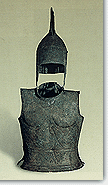

By the end of the 8th century B.C. Argos was already one of the strongest cities of the Peloponnese. Its territory stretched from Thyreatis and Cynuria to the Malean peninsula and to Cythera. Its wealth is further attested by the quality of the Late Geometric and orientalizing pottery produced by its workshops. The Argives may have participated in the colonization of Syracuse, as the existence of Argive pottery there attests; but in other respects they did not take part in colonization, since their possessions' holdings were sufficient for the needs of their population. It is already apparent, even at this date, that Argos was in confrontation with Sparta for the occupancy of Thyreatis, Cynuria, the Malean peninsula, and Cythera. There is eveidence that in the mid-8th century B.C. the Argives came to the help of the Achaeans of Helos, in the crook of the Gulf of Laconia, who were under siege from the Spartans; while in the 1st Messenian War they supported the Messenians. Again, the cities of the Argolid apparently supported the Spartans, because of the pressure they were under from Argos. This is why, during the 1st Messenian War, Eratus king of Argos sacked the neighbouring city of Asine. |  |
 |
The zenith of Argive power is assigned to the second quarter of the 7th century B.C. The king, Pheidon, tried to extend his control to the whole of the north-east Peloponnese, invoking a legend that his ancestro, the Heraclid Temenus, had occupied the realms of Agamemnon and Diomedes. Argos pulled off a decisive victory over Sparta at the battle of Hysiae in Thyreatis, and launched an attack on Olympia, during the Olympic Games of 668 B.C., infringing the sacred truce, in order to transfer control of the shrine to the people of Pisa, detaching it from the inhabitants of Elis. What Pheidon was probably trying to do was extend his influence further, to Corinth; and according to one legend, his death followed swiftly upon his involvement in the disputes preceding the fall of the Bacchiadae and the seizure of power by Cypselus. It was Pheidon (so Ephorus tells us) who minted the first coinage at Aegina and who standardized weights and measures in the Peloponnese. He actually dedicated obeliskoi - iron rods which he introduced as an exchange medium - at the shrine of Hera, somewhere between Argos and Mycenae. |
|
| |
|
Note: Click on pictures to see a short description. | |